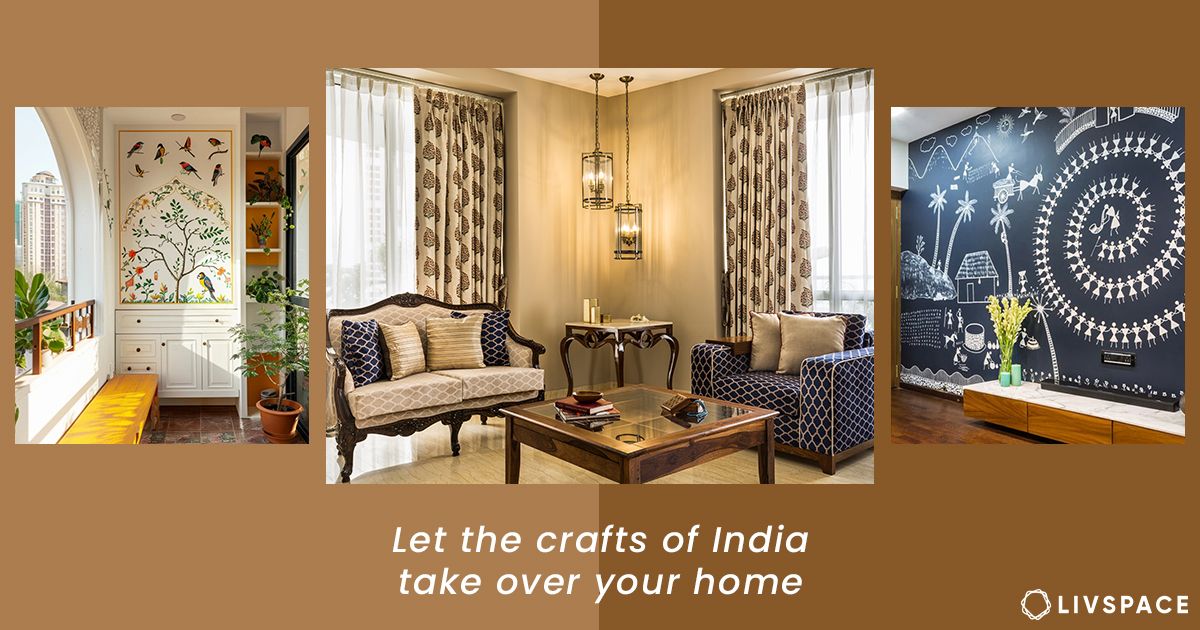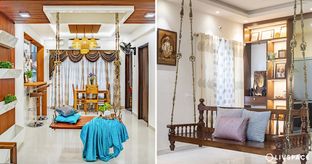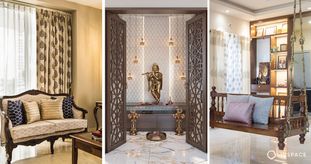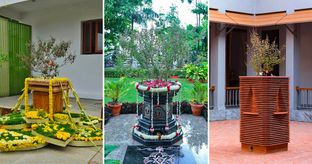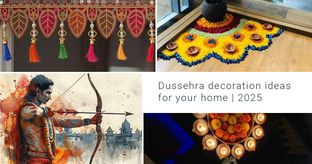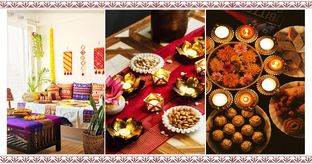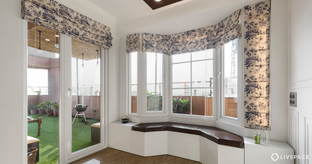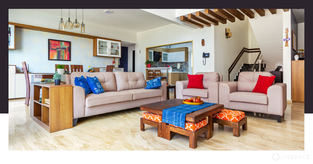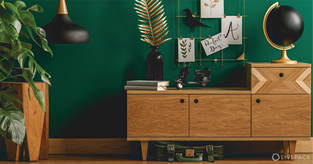In This Article
- Why Indian crafts deserve a place in Indian homes
- Crafts of India #1: Khadi, beyond fashion
- Crafts of India #2: The rustic cane & rattan
- Crafts of India #3: Kalamkari, from temples to home
- Crafts of India #4: Bold Madhubani art
- Crafts of India #5: The Indigenous Warli art
- Crafts of India #6: Dhokra, Timeless metal craft
- Crafts of India #7: Lambani art: The colourful world
- Crafts of India #8: Athangudi tiles
- How can Livspace help you?
In a nondescript village in Andhra Pradesh, an artisan dips a kalam pen into ink as dark as a monsoon night, sketching gods and goddesses onto cotton with a precision that feels almost divine. A thousand miles away, in a Rajasthani hamlet, a weaver’s loom clacks rhythmically, birthing khadi that carries the weight of a nation’s freedom struggle. These are not mere objects but fragments of India’s soul, crafted by hands that have inherited centuries of stories. The crafts of India—khadi, kalamkari, madhubani, warli, dhokra, lambani, and athangudi tiles—are not just relics of a bygone era; they are vibrant, living traditions that deserve a place in every Indian home.
Why Indian crafts deserve a place in Indian homes
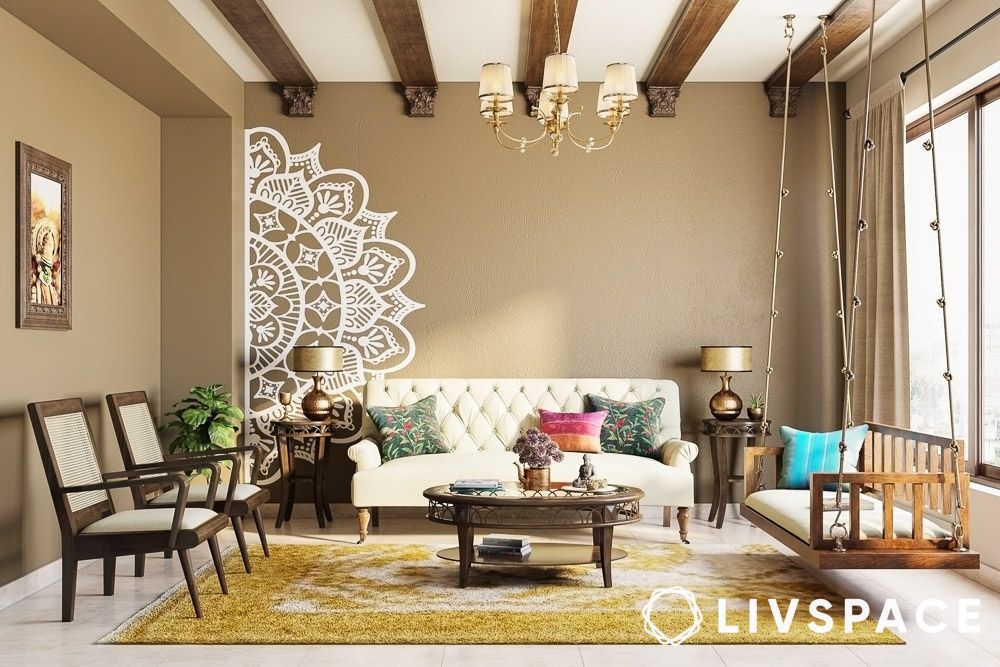
To bring an Indian craft into your home is to invite history itself to take a seat. These crafts are not mass-produced; they are labours of love, often requiring weeks, even months, of meticulous work. Take dhokra, a 4,000-year-old metal-casting technique from Chhattisgarh, or madhubani, born in the ancient kingdom of Mithila. Each piece carries the artisan’s fingerprint, a subtle rebellion against the uniformity of modern decor. They connect us to our roots, reminding us of a time when every object was made with purpose and patience. In a world of fleeting fads, these crafts offer permanence—a way to anchor our homes in something eternal. Did you know that khadi, championed by Gandhi, once sparked a nationwide movement that employed millions? Or that Warli art, with its deceptively simple stick figures, has adorned tribal homes for over 2,500 years? These are not just decorations; they are conversations with history.
Crafts of India #1: Khadi, beyond fashion
What is Khadi, and why use it at home?

Image source: Pinterest @szpyruk
The fabric itself is deceptively simple. Cotton (or silk, or wool) is spun by hand on a charkha, then woven on a handloom. The result is a textile with an almost breathing quality—loose enough to allow air circulation, strong enough to last generations. In a country where summers can melt tarmac, khadi’s natural cooling properties aren’t just beneficial; they’re essential, sustainable home decor.
But here’s what makes khadi revolutionary for interiors: it improves with age. Unlike industrial fabrics that fade and weaken, hand-spun cotton becomes softer and more characterful over time. Each wash adds to its texture, each year deepens its personality.
How to style your home with Khadi?
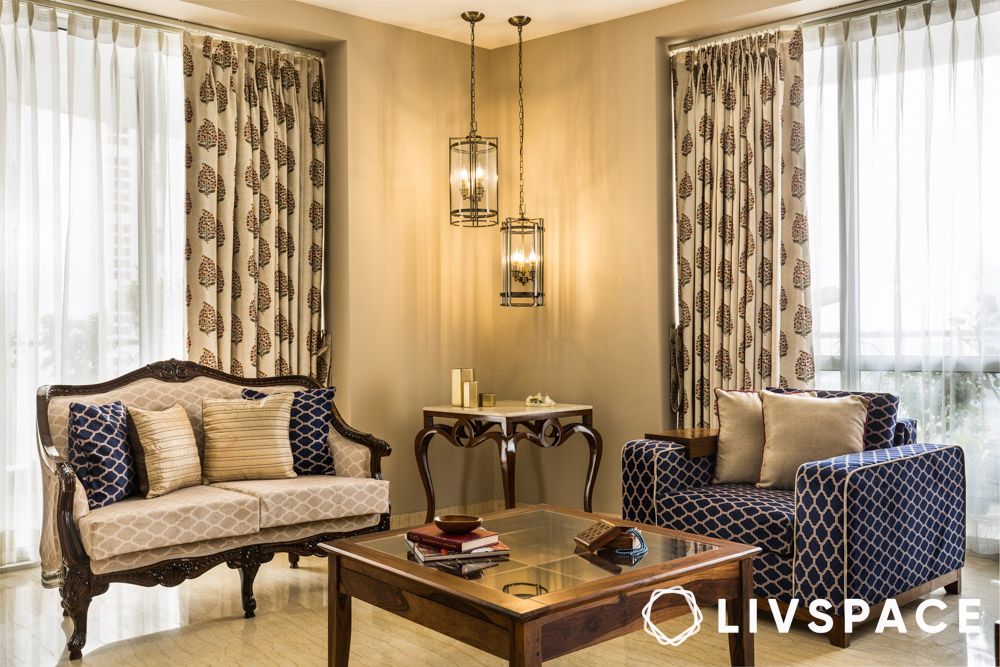
Drape khadi curtains to soften a room’s edges, letting light filter through their gauzy weave. A khadi throw on a sofa adds texture without overwhelming; pair it with jute cushions for a rustic vibe. For a bold statement, upholster a headboard in indigo khadi, or use it as a table runner with terracotta serveware. In a minimalist bedroom, a khadi bedspread in cream or charcoal, accented with a single embroidered cushion, creates serenity. Pro tip: Wash khadi gently by hand to preserve its weave, and avoid bright dyes that might bleed.
Crafts of India #2: The rustic cane & rattan
What is cane & rattan, and why use it at home?
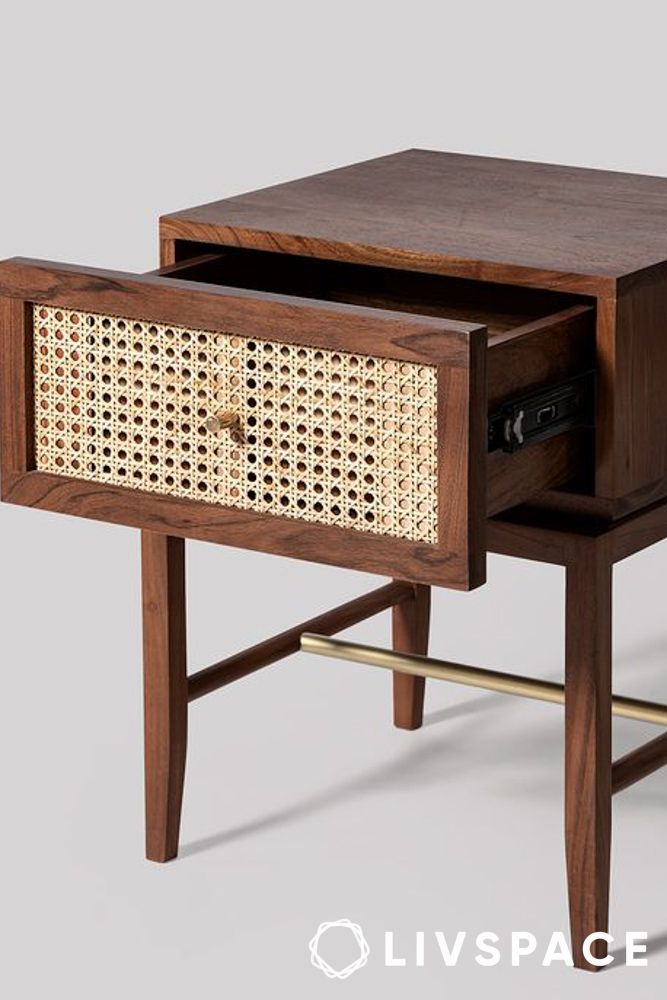
Cane and rattan furniture occupies a peculiar position in the Indian design consciousness. We simultaneously remember it as the height of colonial elegance (every British bungalow had its quota of cane chairs) and dismiss it as old-fashioned. This is rather like rejecting cricket because the English taught it to us, ignoring the fact that we’ve rather improved upon the original.
Cane comes from the outer skin of rattan palms, whilst rattan refers to the inner core. Both are phenomenally practical for Indian conditions: they’re naturally antimicrobial, don’t retain heat, and can withstand humidity that would destroy wooden furniture. Traditional craftsmen in Assam, West Bengal, and Kerala have been working these materials for centuries, developing techniques that make contemporary Scandinavian furniture designers weep with envy.
How to style with cane and rattan?
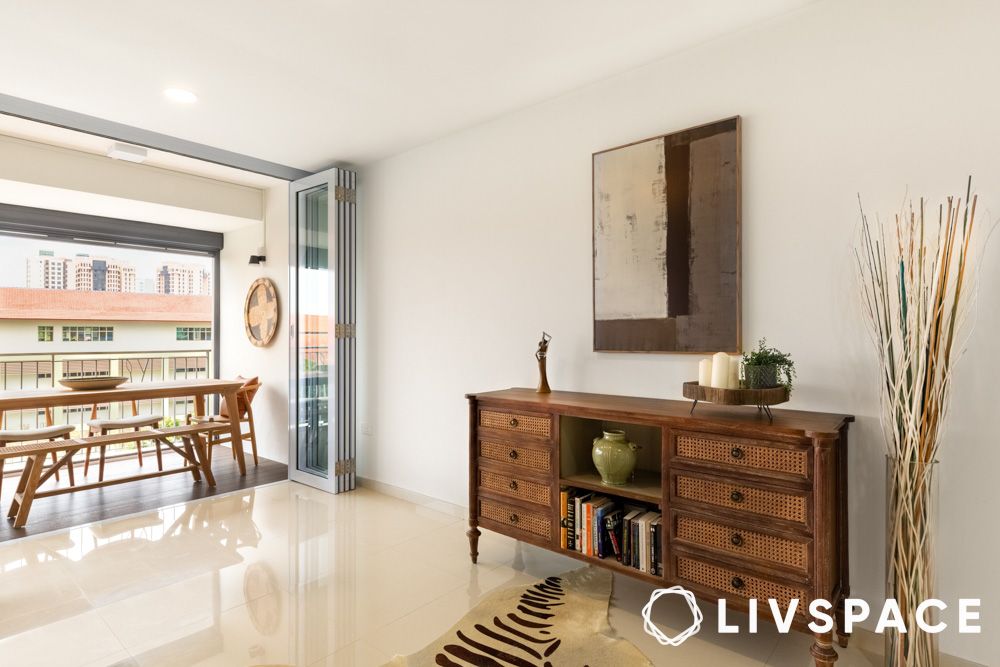
The trick with cane and rattan is to avoid the “colonial club” trap. Instead of complete matching sets, mix pieces with different weave patterns and natural variations. A peacock chair (that gloriously over-the-top high-backed creation) works brilliantly as a statement piece.
Don’t relegate woven pieces to verandas; they work equally well indoors. A rattan room divider can create intimate spaces in large rooms whilst maintaining visual flow. And yes, cane furniture can absolutely handle air-conditioning—another myth we need to dispel.
Crafts of India #3: Kalamkari, from temples to home
What is Kalamkari, and why use it at home?
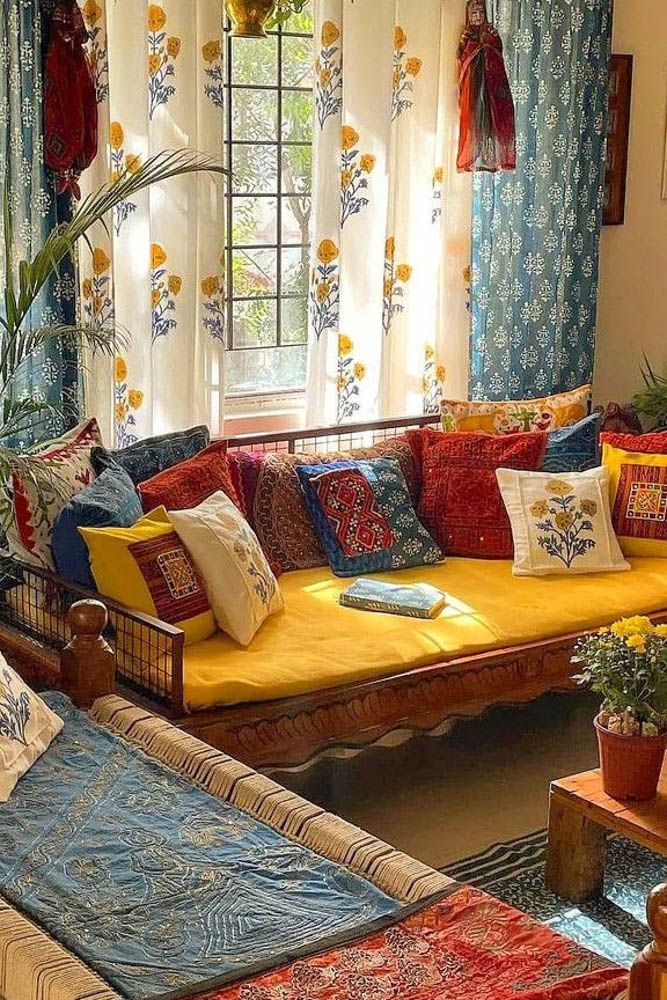
Image source: Pinterest @Qatar_ul_Nidaa
Kalamkari literally translates to “pen work,” which rather undersells the extraordinary artistry involved. This ancient technique from Andhra Pradesh involves drawing intricate designs on cotton using a bamboo pen, then dyeing the fabric through a process so complex it would make modern chemical engineers dizzy.
There are two distinct styles: Srikalahasti kalamkari, which depicts mythological stories and is traditionally used for temple decorations, and Machilipatnam kalamkari, which features Persian-influenced floral motifs and geometric patterns. Both share an extraordinary attention to detail and a colour palette derived entirely from natural sources—pomegranate rinds for yellows, indigo for blues, iron rust for blacks.
How to style with Kalamkari art?
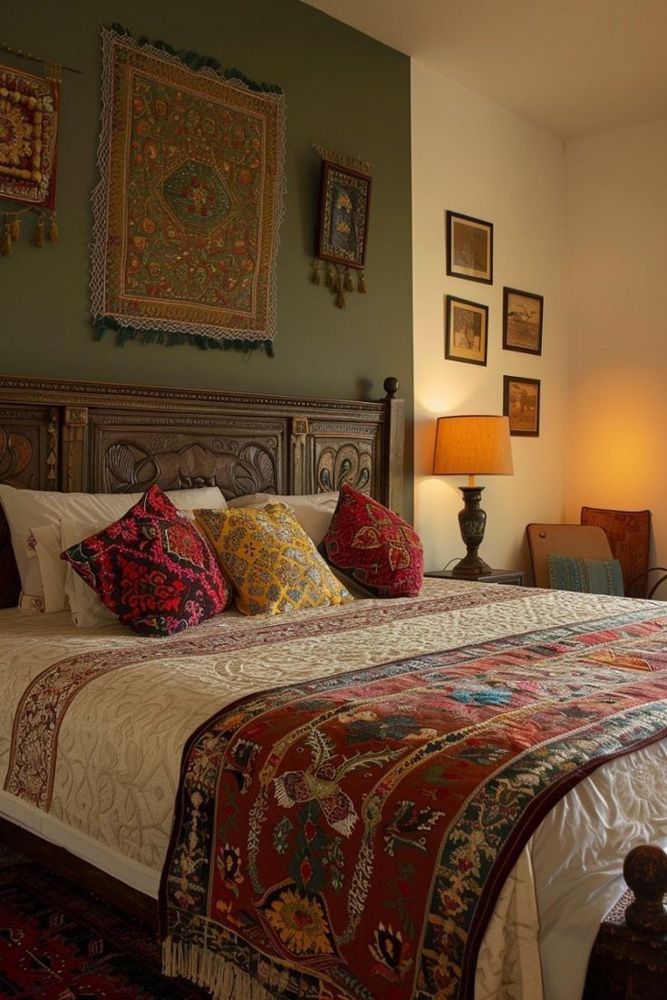
Image source: Pinterest @debjaniacharjee256
Kalamkari’s detailed narratives work best when given space to breathe. A single large kalamkari panel makes a far stronger statement than multiple small pieces competing for attention. Frame it simply—the intricate artwork doesn’t need ornate borders—and position it where natural light can reveal the subtle variations in the hand-drawn lines.
For those nervous about bold artistic statements, start with kalamkari accessories. A throw pillow in muted kalamkari can introduce the technique’s distinctive aesthetic without overwhelming a room. Table runners work particularly well, as they allow diners to examine the intricate work up close. Proof that sustainable home decor doesn’t have to be boring.
Crafts of India #4: Bold Madhubani art
What is Madhubani, and why use it at home?

Image source: Pinterest @oldworldfashion
Originating in Bihar’s Mithila region, this art form began as women’s decoration of mud walls during festivals and weddings. The designs are deliberately geometric and symbolic: fish represent fertility, peacocks symbolise love, and lotus flowers indicate purity.
What makes Madhubani extraordinary is its democratic nature. Unlike court arts that required years of formal training, Madhubani techniques were passed down through generations of women, each adding her own interpretations to traditional motifs. The result is an art form that’s simultaneously ancient and contemporary, formal and playful.
How to style with Madhubani art?
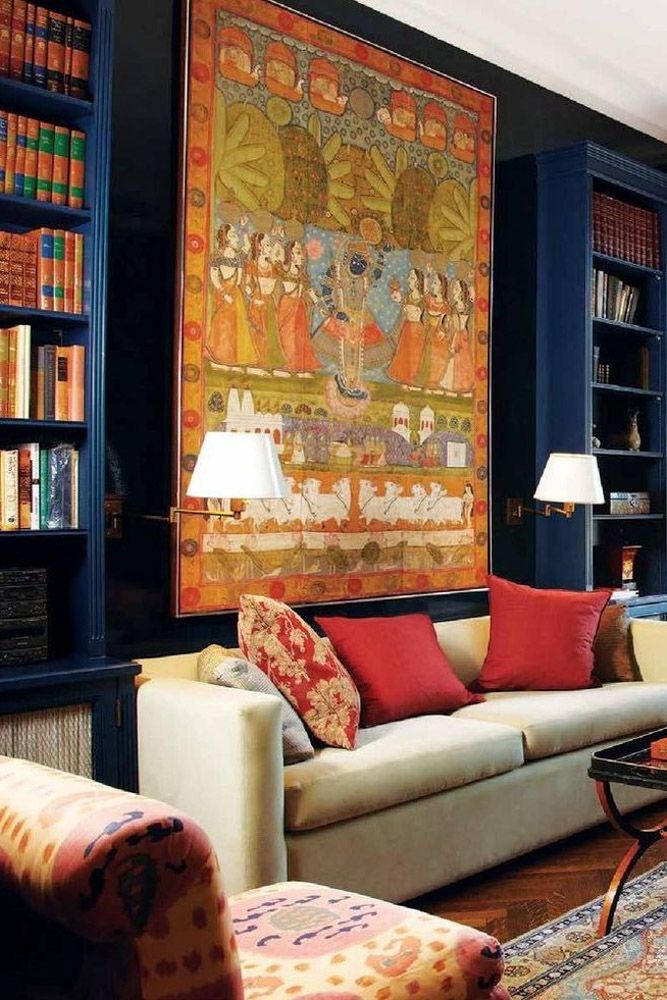
Image source: Pinterest @meowdeliz
Madhubani’s bold graphics work brilliantly in minimalist interior design settings where they can command attention without competition. A single large Madhubani painting can transform a neutral wall into a celebration of colour and pattern. The key is choosing pieces where the traditional palette—predominantly reds, yellows, blues, and blacks—complements your existing scheme.
For maximalist interiors, Madhubani can be layered with other Indian textiles and crafts. The geometric patterns play well with block prints and ikats, creating rich visual conversations. Consider commissioning pieces in non-traditional colours—contemporary Madhubani artists are experimenting with palettes that maintain the form’s energy whilst fitting modern aesthetics.
Also Read: Unique and Unexpected Colourful Interior Design Ideas
Crafts of India #5: The Indigenous Warli art
What is Warli art, and why use it at home?
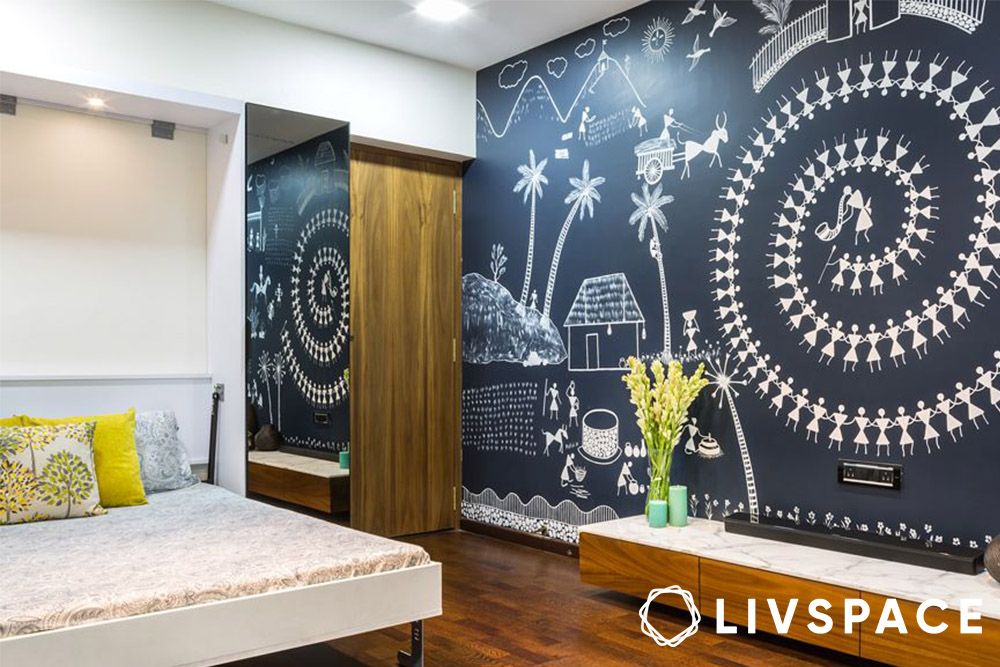
Warli art possesses a quality increasingly rare in our cluttered world: clarity. Created by the Warli tribe of Maharashtra, these paintings reduce complex human experiences to their essential elements. Stick figures dance, work, celebrate, and mourn against backgrounds of geometric patterns that represent the natural world.
The traditional medium is humble: rice paste on mud walls, painted during harvest festivals and weddings. The colour palette is even simpler—white figures on brown backgrounds, occasionally accented with yellow or red. Yet within these constraints, Warli artists create compositions of extraordinary sophistication, depicting everything from daily village life to cosmic philosophy.
How to style with Warli art
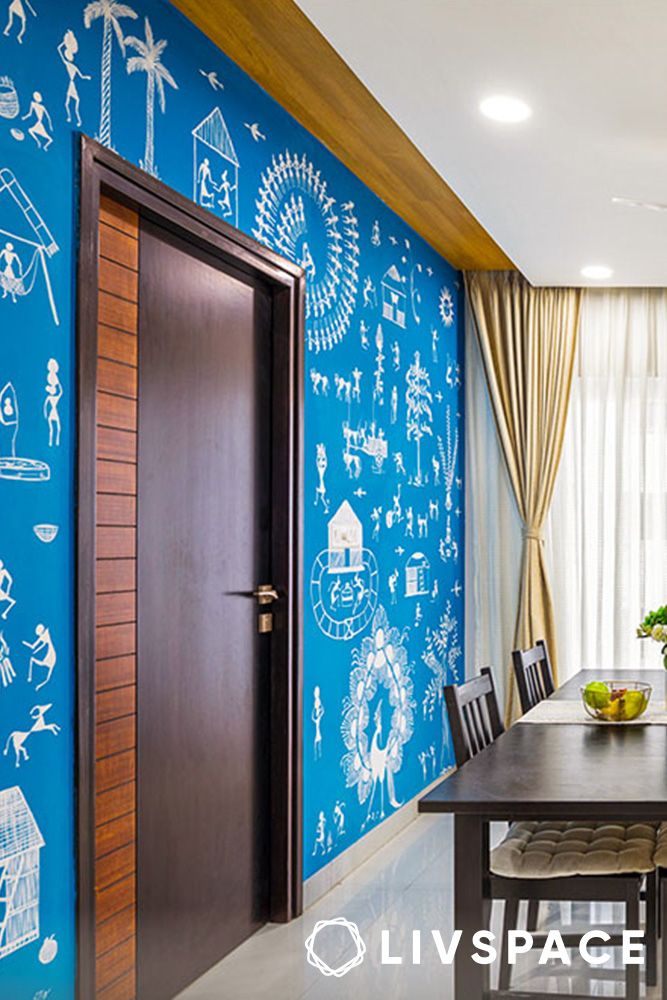
Warli’s monochromatic palette makes it remarkably versatile. A large Warli mural can anchor contemporary living room designs without clashing with existing colours. The earthy tones work particularly well with natural materials—wood, stone, cotton, and jute.
Consider Warli for unexpected applications. A bathroom wall painted with swimming fish motifs, a kitchen decorated with harvest scenes, and a child’s bedroom featuring dancing figures. The art form’s essential optimism makes it perfect for spaces where you want to evoke contentment.
For those hesitant about permanent murals, Warli designs translate beautifully to removable wall decals or large canvas pieces.
Also Read: Wall Art Wonders: Exploring Ideas and Tips for Stylish Home Decor
Crafts of India #6: Dhokra, Timeless metal craft
What is Dhokra, and why use it at home?

Image source: Pinterest @nipaamitbhai
Dhokra represents one of the world’s oldest metallurgy techniques, yet its aesthetic feels thoroughly contemporary. This lost-wax casting method produces brass objects with surfaces that appear both ancient and modern, textured, irregular, utterly handmade yet sophisticated in form.
Traditional Dhokra objects served utilitarian purposes: oil lamps, water vessels, measuring cups, jewellery. But contemporary artisans are creating pieces specifically for modern interiors that work as sustainable home decor: sculptural objects, candle holders, decorative bowls, even furniture hardware.
How to style with Dhokra
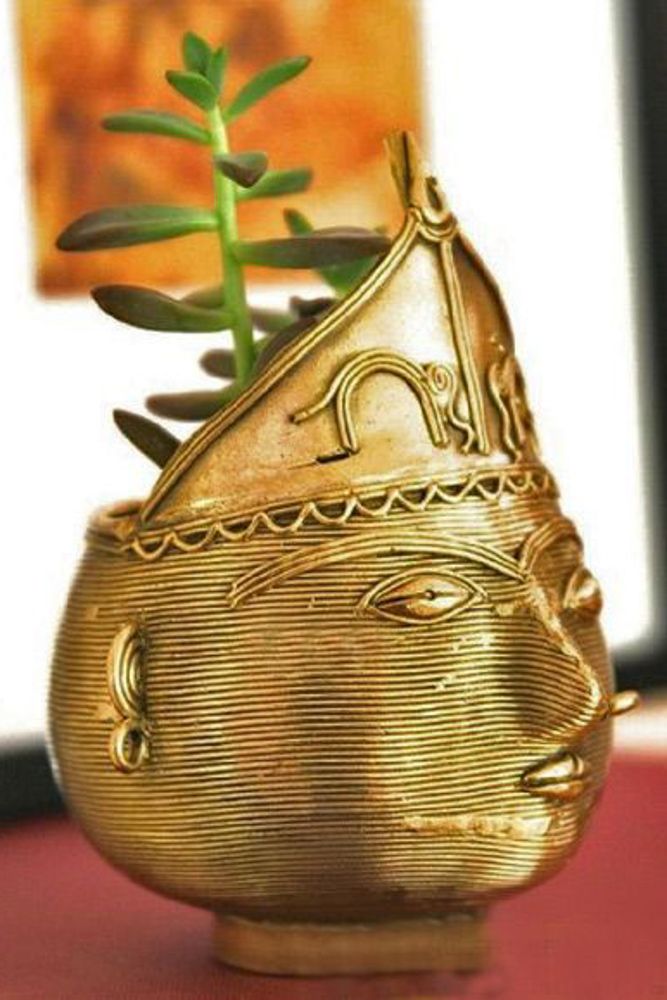
Image source: Pinterest @mauronconi52
The appeal for minimalist homes is obvious. Dhokra’s muted brass tones provide warmth without ostentation, whilst the technique’s inherent irregularities add human character to spare interiors.
Group pieces of varying heights for visual interest, but avoid overcrowding—part of Dhokra’s appeal lies in its substantial presence. Consider functional Dhokra: door or drawer handle designs, cabinet hardware, light fixtures. These applications allow you to introduce the craft’s distinctive texture throughout your home without it feeling applied or decorative.
Crafts of India #7: Lambani art: The colourful world
What is Lambani art, and why use it at home?
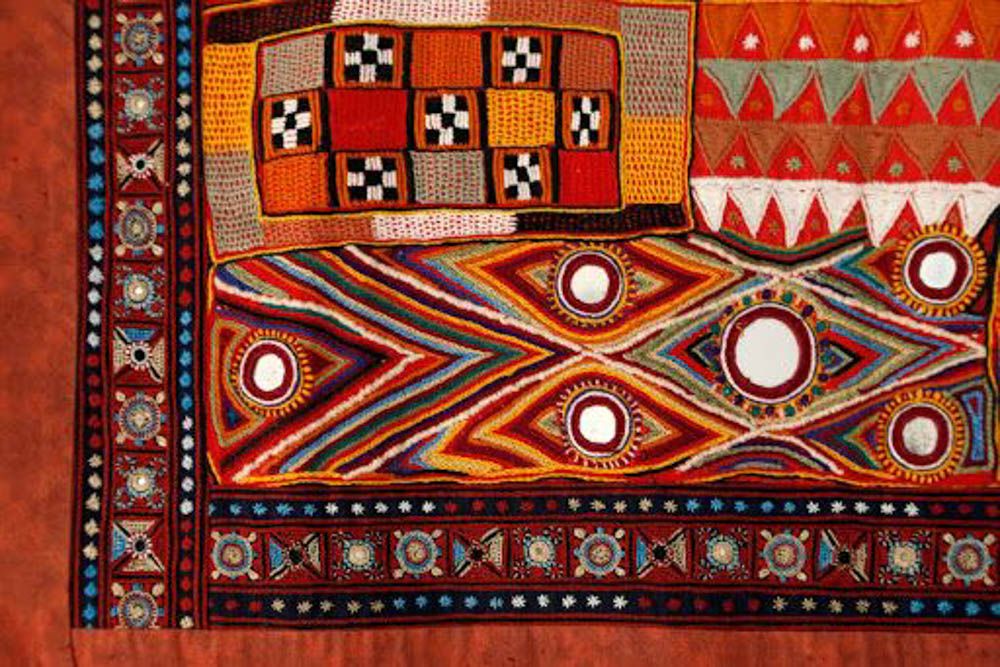
Image source: Pinterest @k_sharma50
The Lambani people, traditionally nomadic communities across Karnataka, Telangana, and Andhra Pradesh, created an art form that celebrates abundance even in scarcity. Using scraps of fabric, mirrors, shells, and beads, Lambani embroidery transforms humble materials into explosions of colour and texture.
What makes Lambani embroidery remarkable is its democratic luxury. These aren’t precious materials requiring vast resources; they’re everyday objects transformed through extraordinary skill and imagination. The technique layers colours and textures with an intuitive understanding of balance that would impress any colour theorist.
How to style with Lambani art?
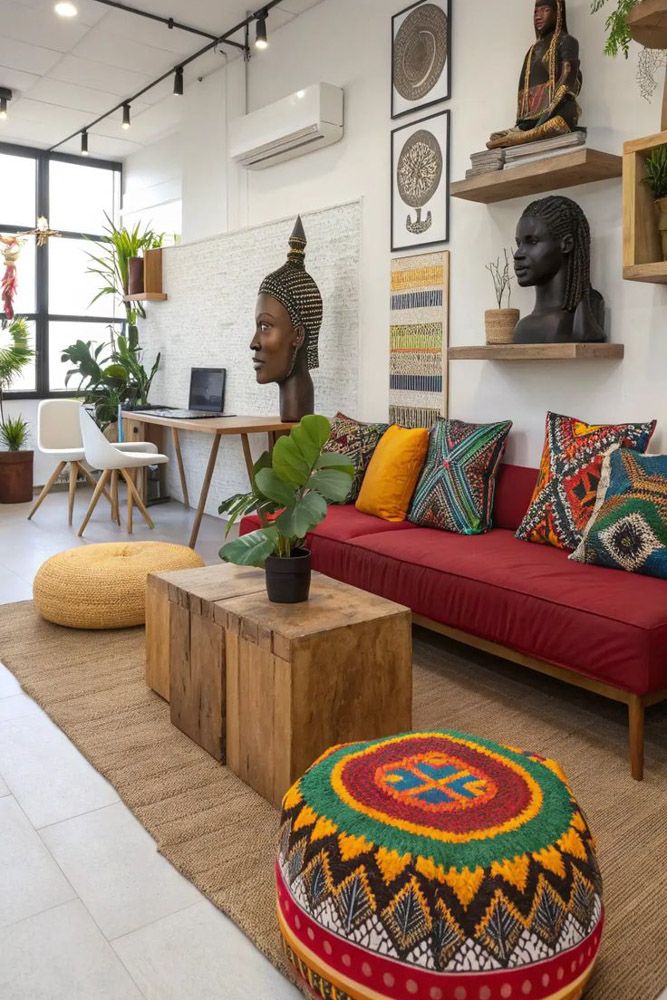
Image source: Pinterest @eleganthomesx
Lambani embroidery works beautifully for accent pieces where rich detail can be appreciated. Cushion covers allow you to introduce the craft’s characteristic mirror work and vibrant threads without committing to large statements. Consider Lambani for unexpected applications: lampshade trims, drawer pulls covered in embroidered fabric, or framed pieces of antique textiles treated as small artworks.
For those with maximalist sensibilities, Lambani can be layered with other Indian crafts. The mirror work plays beautifully with the geometric patterns of Madhubani or the flowing lines of Kalamkari, creating interiors rich in cultural references yet coherent in execution.
Crafts of India #8: Athangudi tiles
What is it, and how to use it at home?

Athangudi tile designs from Tamil Nadu represent the perfect marriage of function and beauty. These cement tiles, made entirely by hand using natural pigments, breathe artistic life into floors. Each tile is poured individually, creating subtle variations that give installed floors a living, breathing quality that machine-made tiles can never achieve.
The process hasn’t changed in over a century: coloured cement is poured into metal moulds, then compressed and cured. The resulting tiles are remarkably durable—many colonial-era installations still look fresh today, whilst their surface patina improves with age and wear. Talk about sustainable home decor.
How to style with Athangudi tiles?
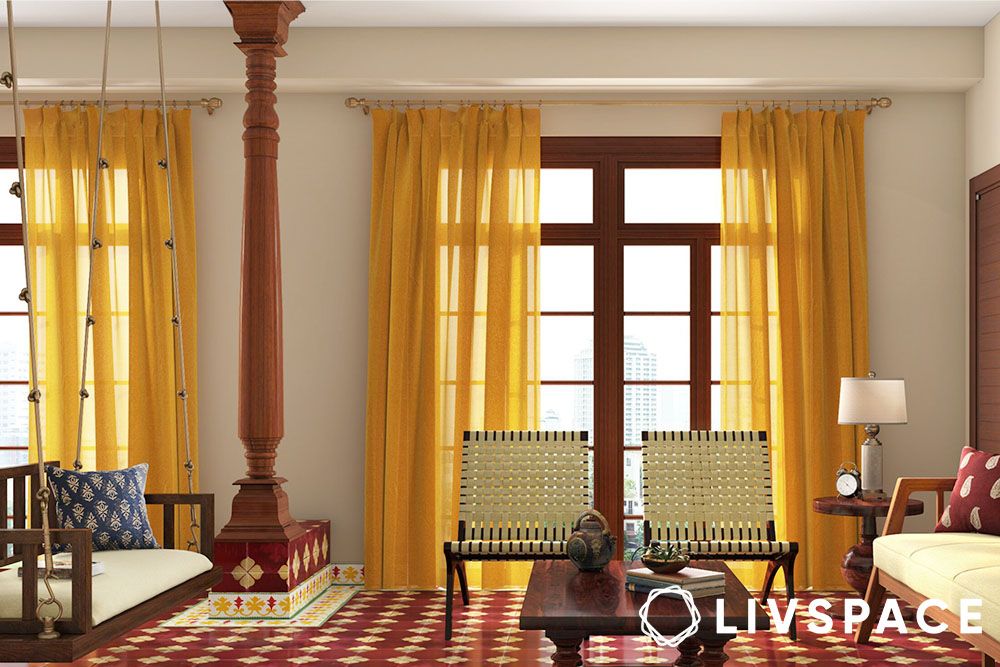
Athangudi tiles work brilliantly for creating zones within open-plan spaces. Use patterned tiles to define seating areas, whilst keeping simpler designs for circulation spaces. The traditional geometric patterns can handle modern furniture without conflict—their strong graphics actually benefit from contemporary pieces’ clean lines.
For smaller applications, consider Athangudi tiles as splashbacks or accent walls. A single wall of patterned tiles can provide all the visual interest a room needs, allowing furniture and accessories to remain simple.
The key is understanding scale. Large patterns work best in generous spaces, whilst intricate designs suit intimate areas where their detail can be appreciated up close.
How can Livspace help you?
We hope you found these crafts of India inspiring! If you want beautiful interiors for your home, then look no further. Connect with a trusted interior designer near you through Livspace today.
- Our expert team can custom-design your dream home with curated render designs and expert advice
- We promise high-quality and durable materials
Not convinced? Check out authentic Livspace reviews from over 75,000 happy homeowners who’ve transformed their spaces with our bespoke designs.
Disclaimer: All contents of the story are specific to the time of publication. Mentions of costs, budget, materials, finishes, and products from the Livspace catalogue can vary with reference to current rates. Talk to our designer for more details on pricing and availability. Please note that the designs within the story are subject to availability and will vary based on the year the homes were designed. Consult our designers for more details on the latest designs.
